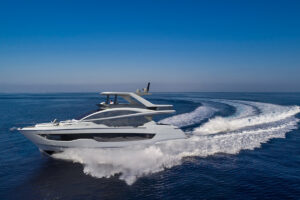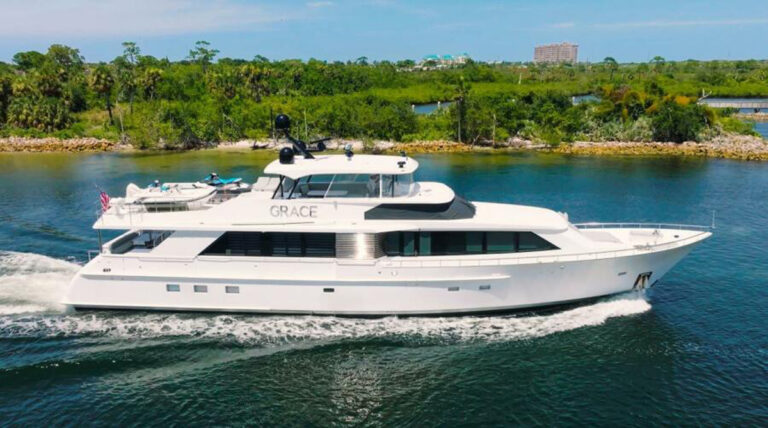If “location, location, location” is the motto of the real estate business, then “purpose, purpose, purpose” is the marine industry counterpart-a mantra no one believes as strongly as Steve Dashew. We saw how Dashew applied function to form in the conception of his legendary Deerfoot and Sundeer sailing yachts. He’s at it again, but this time he’s designed a motoryacht that he affectionately calls the Unsailboat.
The official design brief for the Dashew 83 Offshore Motor Vessel sets some ambitious and even provocative goals: to be “as comfortable as our sailing designs for long ocean voyages” and “capable of making passages of 4,000 to 6,000 miles at an average speed of 12 knots;” to have the “ability to make fast passages to windward in reasonable comfort” and “to cope with heavy weather at least as well as the sailing yachts but at a reduction in the work required by the crew;” to be able to “prepare for long-term storage in half a day” and be removed “from storage within a similar time frame;” to meet the goal of “minimal maintenance, maximal reliability;” and to suit “operation by a crew of one or two.”
Like his sailboats, the last one being Beowulf, the Dashew 83 is narrow for her LOA, has a shallow underbody, is relatively light in weight, and will be built of aluminum and left natural. Everything about this design contributes to the mental comfort of its crew, as Steve Dashew says, a philosophy which explains why Beowulf was named after the Norse hero who killed the demons who were terrorizing a neighboring clan by night. A crew that’s psychologically comfortable-free of anxiety about the yacht’s ability-more easily resists the fatigue and panic that often accompanies bad weather or a mechanical failure.
Comfort in a yacht derives first from the shape of its underbody, followed in close order by the distribution of weight and the arrangement of its living accommodations. The Dashew 83 is as slippery as an eel below the waterline. Her designer gave her a fine entry, which severs the waves as nicely as a Wusthof carving knife parts a slice of standing rib roast. The bottom gains buoyancy in stations three to five, allowing the yacht to ride over the remainder of the wave. Substantial bearing in the after stations keeps the stern from squatting, which reduces the pitching motion. To further manage pitching, Dashew has left the ends empty, placing the engines immediately abaft the last bulkhead and cutting off the accommodations forward at about station four. For this same reason, he’s concentrated the bulk of the weight-fuel and water, battery banks, galley and stores for extended cruises-over the center of buoyancy. The arrangement plan keeps the crew no more than 10 feet from the center of pitch about 95 percent of their time aboard.
If pitching slows the boat and punishes the crew, rolling makes them sick and threatens to toss them hard against the furniture. Common sense may tell us that a narrow yacht rolls more than a wide one, but as Dashew points out, his 83 is inherently stable when it’s running at speed. Anyone who’s paddled a slim kayak or rowed a racing shell knows this. Although the Unsailboat’s beam at the deck is only 17 feet, 10 inches, a little more than 20 percent of her LOA, and her beam at the waterline even less, she won’t roll excessively unless she’s dead in the water, seas on her beam. Dashew’s computational fluid dynamics analysis shows an average roll of plus or minus 4.9 degrees in a significant beam sea. Activating her stabilizers ought to reduce the roll to “little discernable motion,” Dashew says. Anyone asleep in the staterooms will never be more than four feet away from the center of roll. Very comfortable, indeed.
Safety is an extension of the desire for comfort. The characteristics that make the 83 comfortable at sea contribute to her ability to cope with heavy weather. Her shallow underbody and relatively small fins will let her slip sideways when a breaking sea heels her to a certain angle. The shape and buoyancy of her topsides establish her limit of positive stability-the degree of heel from which she’ll recover without capsizing-at 120 to 125 degrees.
The same slippery shape that provides a comfortable motion in a seaway also allows the 83 to run economically at her average cruising speed of 12 knots. Her maximum cruising range, according to the computer, approaches 6,000 miles-this without allowing a reserve. A range of 5,000 seems like a more reasonable goal.
We may argue about the aesthetics of Dashew’s creation until we lose our voices, but no one can honestly say that its form doesn’t follow its function. The Dashews, Steve and Linda, prefer natural aluminum because it doesn’t demand the incessant maintenance of a painted boat. In fact, the aluminum oxide that eventually coats the exterior is tougher than any paint. Unfinished aluminum doesn’t suffer the additional weight of the fairing compounds a painted boat requires to hide aluminum’s inevitable waviness-or the expense of applying them. Nor will you find a single piece of wood on the exterior of the Unsailboat: Who wants to varnish when they could be steaming toward the next destination? For the same reason, getting the 83 ready for storage, or in shape for a voyage after storage, shouldn’t take more than a day-applying bottom paint probably taking up most of the time, or perhaps flushing the antifreeze out of the plumbing if she’s been stored in a cold climate.
The Unsailboat’s straight sheerline and erect pilothouse reminds me of the houses that topped the hunting cabin launches built in the early decades of the 20th century. The vertical windows permit the designer to make maximal use of the yacht’s interior volume, allowing full headroom throughout the area. The large area of glass will make the house, which contains the galley and dining area, delightfully bright on all but the drabbest of days. Storm shutters will protect the windows from being stove in by breaking seas.
On the afterdeck, Dashew devoted 21 feet of the LOA to stowing a RIB and a small sailing dinghy, both of which he’ll launch, using one of the two booms and a Lewmar 66 self-tailing electric winch. The rigging also serves the yacht as emergency propulsion if both engines fail (highly unlikely). The crew can raise one of the booms to near vertical, making it a short mast, and set a 650-square-foot sail. Theory says that the yacht will sail 75 to 100 miles a day in 12 knots of wind.
Avid cruisers of the Dashew’s ilk like to be self-sufficient. They expect to spend as long as a week at anchor without resorting to the generator. Power for the Offshore 83 comes from 3,000 pounds of traction batteries, charged by a pair of 4 kW Electrodyne DC alternators while the boat is under way. The 8 kW generator will let the Dashews run the air conditioner and the clothes dryer.
Although the Dashews have created the 83 Offshore Motor Cruiser from their experience and sensibilities, the concept deserves consideration from anyone who wants to cruise offshore over long distances. The yacht isn’t as roomy as a conventional beamy displacement yacht, but I’ll take her speed and comfort going to windward in a seaway over the massive interior volume that’s most suited to living at the slip. She’s meant to go places in comfort, and stay there for as long as her owners want. Contact: Dashew Offshore, (520) 577-9890; dashoff@setsail.com.









